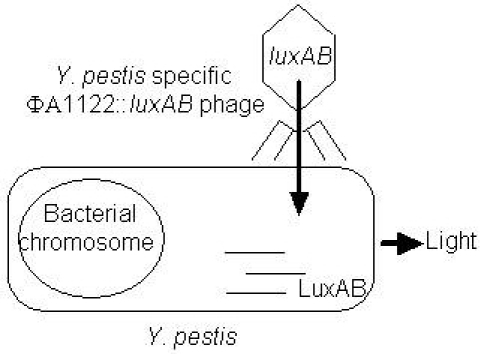"Биолюминесцентный 'Reporter Фаг для обнаружения Категория бактериальных патогенов
Summary
Простой метод определения приоритетных бактериальных патогенов является использование генной инженерии репортер фага. Эти репортер фага, которые являются специфическими для их конкретных видов хозяев, способны быстро трансдуцирующих биолюминесцентного ответный сигнал к клеткам хозяина. Здесь мы опишем использование репортер фага для обнаружения<em> Yersinia Pestis</em>.
Abstract
Yersinia pestis and Bacillus anthracis are Category A bacterial pathogens that are the causative agents of the plague and anthrax, respectively 1. Although the natural occurrence of both diseases' is now relatively rare, the possibility of terrorist groups using these pathogens as a bioweapon is real. Because of the disease's inherent communicability, rapid clinical course, and high mortality rate, it is critical that an outbreak be detected quickly. Therefore methodologies that provide rapid detection and diagnosis are essential to ensure immediate implementation of public health measures and activation of crisis management.
Recombinant reporter phage may provide a rapid and specific approach for the detection of Y. pestis and B. anthracis. The Centers for Disease Control and Prevention currently use the classical phage lysis assays for the confirmed identification of these bacterial pathogens 2-4. These assays take advantage of naturally occurring phage which are specific and lytic for their bacterial hosts. After overnight growth of the cultivated bacterium in the presence of the specific phage, the formation of plaques (bacterial lysis) provides a positive identification of the bacterial target. Although these assays are robust, they suffer from three shortcomings: 1) they are laboratory based; 2) they require bacterial isolation and cultivation from the suspected sample, and 3) they take 24-36 h to complete. To address these issues, recombinant "light-tagged" reporter phage were genetically engineered by integrating the Vibrio harveyi luxAB genes into the genome of Y. pestis and B. anthracis specific phage 5-8. The resulting luxAB reporter phage were able to detect their specific target by rapidly (within minutes) and sensitively conferring a bioluminescent phenotype to recipient cells. Importantly, detection was obtained either with cultivated recipient cells or with mock-infected clinical specimens 7.
For demonstration purposes, here we describe the method for the phage-mediated detection of a known Y. pestis isolate using a luxAB reporter phage constructed from the CDC plague diagnostic phage ΦA1122 6,7 (Figure 1). A similar method, with minor modifications (e.g. change in growth temperature and media), may be used for the detection of B. anthracis isolates using the B. anthracis reporter phage Wβ::luxAB 8. The method describes the phage-mediated transduction of a biolumescent phenotype to cultivated Y. pestis cells which are subsequently measured using a microplate luminometer. The major advantages of this method over the traditional phage lysis assays is the ease of use, the rapid results, and the ability to test multiple samples simultaneously in a 96-well microtiter plate format.

Figure 1. Detection schematic. The phage are mixed with the sample, the phage infects the cell, luxAB are expressed, and the cell bioluminesces. Sample processing is not necessary; the phage and cells are mixed and subsequently measured for light.
Protocol
Discussion
Этот метод демонстрирует способность репортер фага для оперативного выявления Y. Pestis с репортером фага может преобразовывать биолюминесцентного ответный сигнал, культурный Y. Pestis клетки в течение 20 минут после того фага. Репортер фага также способен непосредственно обнаруже…
Disclosures
The authors have nothing to disclose.
Acknowledgements
Это исследование было поддержано малого бизнеса инновационных исследований программы Национального института здоровья (NIAID, 1R43AI082698-01) и Министерства сельского хозяйства США Национального института сельского хозяйства и продовольствия (НИФА, 2009-33610-20028).
Materials
| Name of the reagent | Company | Catalogue number |
|---|---|---|
| Difco LB agar, Miller | VWR | 90003-346 |
| Difco LB broth, Miller | VWR | 90003-350 |
| 17 x 100 mm culture tubes | USA Scientific | 1485-0810 |
| n-Decanal | Sigma | D7384 |
| Veritas microplate luminometer | Turner Biosystems | 9100-001 |
| Microlite microtiter 96-well plate | VWR | 62402-984 |
References
- Darling, R. G., Catlett, C. L., Huebner, K. D., Jarrett, D. G. Threats in bioterrorism. I: CDC category A agents. Emerg Med Clin North Am. 20, 273-309 (2002).
- Chu, M. C. . Laboratory manual of plague diagnostic tests.. , (2000).
- . . , (1999).
- Inglesby, T. V. Anthrax as a biological weapon, 2002: updated recommendations for management. JAMA. 287, 2236-2252 (2002).
- Schuch, R., Fischetti, V. A. Detailed genomic analysis of the Wbeta and gamma phages infecting Bacillus anthracis: implications for evolution of environmental fitness and antibiotic resistance. J Bacteriol. 188, 3037-3051 (2006).
- Garcia, E. The genome sequence of Yersinia pestis bacteriophage phiA1122 reveals an intimate history with the coliphage T3 and T7 genomes. J Bacteriol. 185, 5248-5262 (2003).
- Schofield, D. A., Molineux, I. J., Westwater, C. Diagnostic bioluminescent phage for detection of Yersinia pestis. Journal of Clinical Microbiology. 47, 3887-3894 (2009).
- Schofield, D. A., Westwater, C. Phage-mediated bioluminescent detection of Bacillus anthracis. Journal of Applied Microbiology. 107, 468-478 (2009).
- Chu, M. C. . CDC: Basic laboratory protocols for the presumptive identification of Yersinia pestis. , 1-19 (2001).
- Gunnison, J. B., Larson, A., Lazarus, A. S. Rapid differentiation between Pasteurella pestis and Pasteurella pseudotuberculosis by action of bacteriophage. J Infect Dis. 88, 254-255 (1951).
- Lazarus, A. S., Gunnison, J. B. The Action of Pasteurella pestis Bacteriophage on Strains of Pasteurella, Salmonella, and Shigella. J Bacteriol. 53, 705-714 (1947).
- Sergueev, K. V., He, Y., Borschel, R. H., Nikolich, M. P., Filippov, A. A. Rapid and sensitive detection of Yersinia pestis using amplification of plague diagnostic bacteriophages monitored by real-time PCR. PLoS One. 5, e11337-e11337 (2010).

